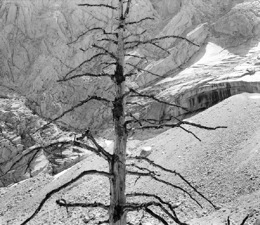As if drought and wildfires weren’t enough, California’s coniferous forests face another climate-related threat

In the last decade, tiny forest-dwelling beetles have wiped out pine trees on millions of acres in the Canadian and American West, including Southern California. The rest of the state has been largely spared, but forest ecologists say that’s likely to change.
Reporter Ilsa Setziol recently spent some time tracking these bugs with an entomologist from the US Forest Service. They found beetles at work in Jeffrey pines and coulter pines in the San Bernardino National Forest, east of Los Angeles.
You can hear her radio feature on The California Report, produced by KQED Public Media.
2 thoughts on “Beetlemania Creeping Into California”
Comments are closed.

While I’m grateful for Ms. Setzoil’s concern about Southern California’s national forests, it is regrettable that she only reported the Forest Service’s position on this issue. Unfortunately, the Forest Service has a long history of trying to manufacture justifications for more logging on our national forests. Let’s not forget that for decades the Forest Service claimed that logging old growth was good for the forests. Now they are trying to repackage their timber sales by stoking fears of fire and beetles. But if Ms. Setzoil has interviewed an environmental organization that does not have a vested interest in logging, such as the John Muir Project, she would have found that the pretexts for logging given by Mr. Safford of the Forest Service simply don’t hold up to the best available science. To learn more about that science, I recommend the report “The Myth of ‘Catastrophic’ Wildfire” by Dr. Chad Hanson, available on the John Muir Project website.
Global warming continues at a record pace.New study just out from Boulder, Colorado states that the permafrost melt and the potential melt of the frozen methal hydrates off the shallow Arctic shelf have a potential to put 190 gigatons of co2 and methane into the atmosphere within 20 years.Some believe the planet could stabilise at 1000 ppm by year 2100.This would be an unmitigated and unstoppable disaster.The planet would warm to such an extent that it would become uninhabitable for the most part by year 2200.All signs now point to a massive release of co2 and methane from the permafrost melt within 20 years.Looks completely unstoppable.Hawkins believes that a runaway Venus greenhouse effect is not out of the question.For the look of a 1000 ppm world see the work of James Hansen and Peter Ward.The permafrost data assumes a moderate decline in human co2 output (currently still rising fast).For the past 800,000 years co2 was at 200 ppm.Now approiaching 400 ppm.The planet with business as usual will not stabilize below 1000 ppm. End of story.End of humans and biodiversity.
Mark J. Fiore